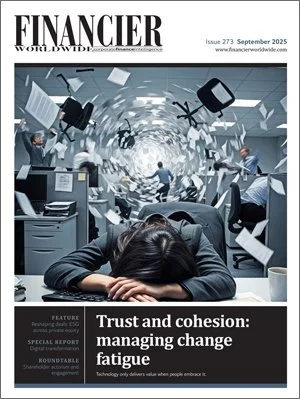Sanctions in the age of AI
September 2025 | FEATURE | GLOBAL TRADE
Financier Worldwide Magazine
Sanctions have gained increasing prominence in recent years. Both companies and consumers have become more aware of their significance and growing prevalence, particularly as sanctions are increasingly employed as a foreign policy instrument by governments around the world.
Sanctions are powerful tools used by governments and international bodies to disrupt the financial and trade activities of targeted regimes, individuals or entities. They block access to assets, restrict transactions, and limit trade in key goods and services.
The rapid expansion of sanctions has made compliance far more complex. With thousands of new measures introduced globally – particularly by the European Union – companies face mounting pressure to screen for a growing list of targets. This surge in restrictions increases the risk of enforcement, reputational damage and costly penalties. Sanctions screening is now a dynamic, high-stakes process requiring constant vigilance. Companies must navigate overlapping regulations, cross-border enforcement and the rising threat of trade-based financial crime – all while adapting to an ever-shifting global landscape.
AI and the sanctions frontier: navigating the digital grey zone
While sanctions frequently target individuals and entities through measures such as asset freezes, they also encompass broader economic and trade restrictions, including export controls on certain goods and services. These restrictions increasingly extend to artificial intelligence (AI) software and technologies, which are becoming integral to numerous sectors. It is therefore essential for stakeholders to understand the sanctions risks associated with the development and deployment of AI.
The rapid growth of AI has prompted governments and international bodies to impose new restrictions on the export, import and use of certain AI technologies, particularly where national security, human rights or geopolitical concerns are involved. For example, some jurisdictions have begun to restrict the transfer of AI models and training datasets to countries deemed high-risk, citing concerns over surveillance, autonomous weapons development and misuse of generative tools. These measures reflect a growing recognition that AI is not just a commercial asset but a strategic resource with far-reaching implications.
“Policymakers may need to consider new classification systems tailored to digital goods, alongside enhanced international cooperation to harmonise AI-related trade controls.”
AI presents unique challenges in the context of sanctions. Software in general is difficult to classify under existing sanctions and export control frameworks. It can be easily modified, distributed digitally and applied in ways that may not have been foreseen by its developers. This lack of a consistent classification system makes it difficult to regulate effectively. These challenges are especially pronounced for AI software, which often falls outside the scope of regulatory frameworks originally designed for physical goods. As a result, AI technologies can be exploited to circumvent existing sanctions, increasing the risk of violations. The adaptability of AI tools – particularly open-source models – means they can be repurposed for sensitive applications without detection, making enforcement even more complex.
AI software frequently lies beyond the reach of the World Customs Organization’s Harmonized Commodity Description and Coding System (HS Code), which is used by over 200 countries to classify traded products for customs, tariffs and trade controls. The HS Code system, last updated in 2022, does not yet include dedicated categories for emerging technologies such as generative AI. This creates uncertainty for traders and customs authorities, leading to inconsistent treatment across jurisdictions. In some cases, AI software may be bundled with other digital services, further obscuring its classification and complicating efforts to monitor its movement across borders.
The challenge is compounded by the fact that AI software is often delivered digitally – via cloud services, application programming interfaces or downloads – meaning it may not be associated with an HS Code at all. This lack of physical shipment or customs declaration makes enforcement significantly more difficult. Malicious actors may exploit these digital delivery channels to bypass traditional customs and sanctions oversight. Without a clear audit trail, regulators face significant hurdles in tracing the origin, destination and intended use of AI technologies, especially when transactions occur across decentralised platforms or encrypted networks.
Looking ahead, the limitations of the current HS taxonomy in classifying, regulating and valuing intangible, multifunctional and rapidly evolving digital products such as AI software will necessitate substantial reform. The existing gaps in the HS Code are already creating legal, regulatory and operational challenges for businesses, customs authorities and policymakers. These challenges are likely to intensify as investment in advanced technologies continues to accelerate. Policymakers may need to consider new classification systems tailored to digital goods, alongside enhanced international cooperation to harmonise AI-related trade controls.
The effectiveness of AI-related sanctions will depend on the development of new digital trade control frameworks, as well as the ability of companies to implement robust mitigation strategies to reduce the risk of sanctions breaches. This includes investing in AI governance tools, conducting regular risk assessments, and ensuring that compliance teams are equipped to monitor emerging threats in real time.
© Financier Worldwide
BY
Richard Summerfield


